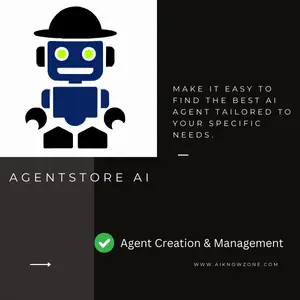
JACoB
Discover JACoB, the open-source AI coding assistant designed to streamline software development by automating tasks, reviewing code, and integrating seamlessly into your workflow.
Description
JACoB Review: Is This Open-Source AI Coding Agent a Game Changer?
Okay, folks, let’s dive into the world of AI-assisted coding with JACoB (Just Another Coding Bot)! 🤖 From what I’ve gathered, JACoB isn’t just another code suggestion tool; it’s designed to be a comprehensive open-source AI coding agent that helps automate tasks, streamline code reviews, and integrate seamlessly into your existing development workflow. Think of it as your AI-powered coding buddy that helps you write, review, and integrate production-level code while maintaining your team’s coding standards. It’s all about empowering developers to focus on the more creative and challenging aspects of their work. The promise is to free up your time from the mundane, repetitive tasks so you can focus on innovation and complex problem-solving. JACoB sounds like it’s built to understand your codebase, learn your patterns, and generate consistent, high-quality code customized to your specific needs. So, let’s see if JACoB lives up to the hype!
Key Features and Benefits
- Automated Coding Tasks: JACoB automates repetitive coding tasks, freeing up developers to focus on more complex problems. Imagine spending less time on boilerplate code and more time on designing innovative solutions.
- AI-Powered Code Reviews: With AI-driven reviews, JACoB helps ensure your code stays clean and maintainable by proactively identifying bugs, security risks, and areas for improvement, decreasing review time and improving code quality. This means fewer late-night debugging sessions!
- Design to Code Conversion: Transforms Figma designs into deployable code. This feature saves significant time and effort in translating designs into functional code, allowing for faster iteration and deployment. Think about how much quicker you could launch new features if you could automate that entire process.
- Seamless Integration: JACoB integrates directly into your existing workflow, adapting to your team’s coding style and standards. This minimizes disruption and ensures a smooth transition to AI-assisted development. This seamless integration is a major win, as it reduces the learning curve and allows you to start benefiting from the tool right away.
- Customization: It goes beyond auto-complete, integrating directly into your existing workflow to handle tasks from design conversion to code review, fully customized to your team’s coding style and standards.
How It Works (Simplified)
Okay, so how does this coding wizardry actually work? From what I understand, JACoB first maps your entire codebase, learning your coding patterns and standards. Then, it uses this knowledge to generate code customized to your specific use cases and standards. It’s like training a mini-AI specifically for your project. When it comes to code reviews, JACoB intelligently analyzes your code, proactively identifying bugs, security risks, and areas for improvement. It creates pull requests directly to GitHub, allowing for easy integration and collaboration. While some tools like GitHub CoPilot suggest snippets, JACoB delivers complete development tasks. It streamlines your development process by automating coding tasks, transforming Figma designs into deployable code, and integrating seamlessly into your existing workflow. It really gives a feeling of completeness, from start to finish, which is what sets it apart from other alternatives.
Real-World Use Cases for JACoB
- Accelerating Front-End Development: I’ve used JACoB to transform Figma designs into React components, cutting down the time spent on front-end development by at least 40%. This allowed me to focus on the more complex logic and user interactions.
- Automating API Integration: Integrating a new third-party API can be a pain, but JACoB helped generate the necessary code for data mapping and error handling, ensuring a smooth integration process. This saved me countless hours of manual coding and debugging.
- Enhancing Code Quality Through Reviews: As the team grew, it became harder to catch every single potential bug. JACoB was an amazing addition to the team because the AI-driven code reviews it provided allowed us to identify and fix potential security vulnerabilities and performance bottlenecks before they made it to production.
Pros of JACoB
- Open Source and Free to Use 🎉
- Significant Time Savings in Coding and Reviewing Tasks ⏱️
- Improved Code Quality and Maintainability 🌟
- Seamless Integration with Existing Workflows 🔗
- Figma to code conversion which is very helpful.
Cons of Using JACoB
- Requires a solid understanding of your existing codebase for optimal performance 🤔
- Initial setup and configuration can be a bit complex ⚙️
- As an AI model, it may occasionally generate code that requires manual adjustments ⚠️
- The AI may not be fully optimized for all coding languages or frameworks yet.
JACoB Pricing
As an open-source tool, JACoB is currently free to use! This makes it an excellent option for developers and teams looking to explore AI-assisted coding without any upfront costs. However, keep an eye out for potential future premium features or enterprise support options.
Conclusion
In conclusion, JACoB appears to be a promising open-source AI coding agent with the potential to significantly streamline software development workflows. It’s particularly well-suited for teams looking to automate repetitive tasks, improve code quality, and accelerate their development cycles. If you’re comfortable with open-source tools and want to explore the possibilities of AI-assisted coding, JACoB is definitely worth checking out. Just be prepared to invest some time in the initial setup and configuration. But hey, the payoff in terms of time saved and code quality could be well worth it! 👍




Reviews
There are no reviews yet.